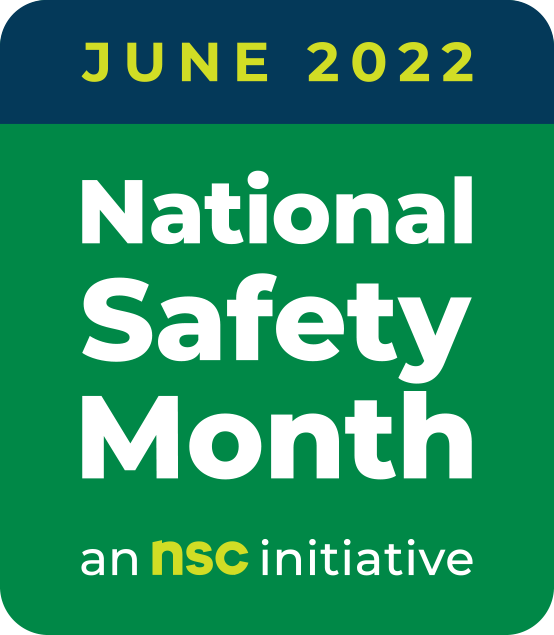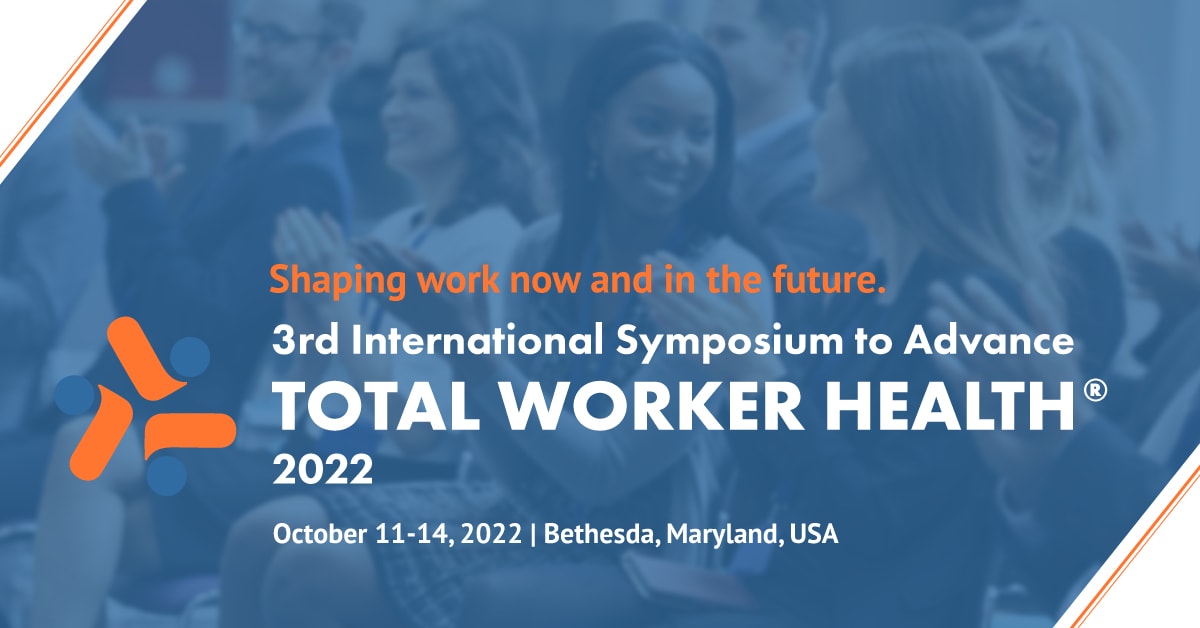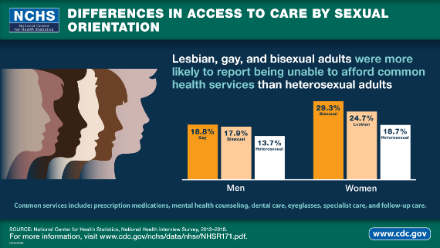eNews: Volume 20, Number 2 (June 2022)
Volume 20, Number 2 (June 2022)
From the Director’s Desk
John Howard, M.D. Director, NIOSH
The 3rd International Symposium to Advance Total Worker Health®
I am pleased to share that this October, NIOSH is joining with the Center for Health, Work & Environment, Colorado School of Public Health, to host the 3rd International Symposium to Advance Total Worker Health®.
The theme for the third symposium is “Shaping Work Now and in the Future.” The agenda is designed to offer the latest research findings and newest insights into the challenges workers and employers face in a rapidly evolving post-pandemic environment.
This symposium will bring together an audience of safety and health professionals; workplace well-being, health promotion, and mental health providers; human resources and benefits professionals; employers; researchers; policymakers; organized labor representatives; and members of the academic community.
Attendees will hear from experts in the field during keynote addresses, presentations, workshops, and “bright spots,” a new conference feature. Presentations will explore opportunities to prioritize healthy work design and improve the health and well-being of all workers and the safety and quality of work across all industries and occupations. This is the only NIOSH-sponsored event focused solely on advancing Total Worker Health (TWH) research, practice, policies, and programs.
The symposium will be held October 11–14 at the National Institutes of Health Natcher Conference Center in Bethesda, Maryland. For the first time, a hybrid conference model will be used that offers many conference events virtually, as well. Registration opens June 27. There will be an early bird discount, as well as opportunities to apply for scholarships.
The symposium builds upon successful past meetings, including the 2004 NIOSH Steps to a Healthier U.S. Workforce Conference, the 2007 NIOSH WorkLife National Symposium, and the 2014 and 2018 International Symposiums to Advance TWH.
I had the pleasure of presenting the keynote address at the first symposium in 2014. Since then, we’ve raised awareness and generated new knowledge to benefit workers, employers, and communities. However, there is still work to do to address both new and long-standing threats to workers’ safety, health, and well-being.
Join me as we explore the latest research and practical applications of TWH in real-world settings. Visit the symposium website for more on registration, local area information, and the agenda.
To learn more about TWH at NIOSH, visit our webpage and sign up for the TWH in Action! Newsletter.
New Tool Estimates Future N95 Respirator Need
One of many lessons learned during the COVID-19 pandemic is that we need to have an adequate supply of N95 respirators, which were in short supply early in the pandemic. Efforts have been made to address this issue for healthcare workers. Now, NIOSH researchers have developed a tool they used to estimate the number of N95 respirators needed to protect nonhealthcare essential workers, according to research recently published in the journal Health Security. The tool is available in the article’s supplemental material.
The spreadsheet-based tool was built from another tool previously designed to estimate the number of N95 respirators needed to protect workers during a flu pandemic. For the current tool, researchers used information from the U.S. Department of Homeland Security, the U.S. Bureau of Labor Statistics, and the Occupational Information Network. They identified nonhealthcare essential occupations and the number of workers they employ. With this information, researchers estimated about 85 million nonhealthcare essential workers could need N95 respirators during another pandemic spread by aerosol. Next, they looked at three possible scenarios of N95 respirator needs for pandemics lasting 15 and 40 weeks: minimum, which would require one N95 respirator per week; intermediate, which would require two N95 respirators per week; and maximum, which would require five N95 respirators per week.
Using the tool, researchers estimated that nonhealthcare essential workers would need about 1.3 billion N95 respirators for the minimum scenario for the first 15 weeks. That need would increase to 2.6 billion respirators for the intermediate and 6.4 billion for the maximum scenarios. Estimates rose for a 40-week long pandemic to 3.4 billion for the minimum, 6.8 billion for the intermediate, and 17 billion for the maximum scenarios.
These findings can help public health officials and policymakers prepare for future emergencies and plan for available N95 respirators for nonhealthcare essential workers. The tool can also be applied to other types of personal protective equipment, in addition to N95 respirators.
More information is available:
- NIOSH-approved N95 Particulate Filtering Facepiece Respirators
- CDC | Infection Control Guidance for Healthcare Professionals about Coronavirus (COVID-19)
Dissemination & Implementation Science Aids Total Worker Health® Intervention
Occupational safety and health relies on the translation of research to practice, which applies interventions where they are needed: in the workplace. This is where the study of intervention delivery, or dissemination and implementation (D&I) science, comes into the picture. Selecting the best delivery strategy for a given workplace is critical for an intervention’s success.
In the International Journal of Environmental Research and Public Health, researchers at the Center for Health, Work & Environment (CHWE) recently published a study applying D&I science for designing and evaluating a Total Worker Health® (TWH) intervention. The TWH approach, which NIOSH developed, is defined as comprehensive policies, practices, and programs that integrate worker well-being promotion and occupational safety and health.
CHWE, 1 of 10 NIOSH Centers of Excellence for TWH, developed Health Links™, an intervention aimed at improving the adoption and implementation of TWH in small- and mid-sized businesses through an existing D&I framework. Known as RE-AIM, this framework includes five principles: reach, effectiveness, adoption, implementation, and maintenance. Researchers used these principles to gather information, identify needs and barriers, and select and tailor strategies ready to scale up and build buy-in from partners and collaborators. They continued to evaluate and adapt their plans over seven years.
The researchers found that RE-AIM helped with intervention planning and evaluation. Major conclusions included the need for continual evaluation of the intervention to adapt key implementation strategies and establishing relationships with partners to identify the various factors that impact its adoption. The next steps include conducting research on how to adapt TWH interventions for businesses as they face changing demands.
More information is available:
Director’s Desk
Research Rounds
- New Tool Estimates Future N95 Respirator Need
- Dissemination & Implementation Science Aids TWH® Intervention
Highlights
- Just Released: U.S. Surgeon General Advisory Addresses Burnout for Health Workers
- Celebrate National Safety Month!
- World Trade Center Health Program Launches Virtual Exhibition
- Nominations Open For Annual Safe-In-Sound Excellence in Hearing Loss Prevention Award
- Updated NIOSH Careers Webpage
- Upcoming Webinars
- NIOSH Worker Well-Being Questionnaire (WellBQ) Updates
- Identifying Research Priorities to Reduce Risks From Work Hours & Fatigue in Healthcare & Social Assistance
- Webinar Recording Now Available: What Is Safety Climate?
Monthly Features
John Howard, M.D., Director
Christina Spring, Editor in Chief
Managing Editor
Tanya Headley
Section Editor
Anne Blank, Research Rounds
Kiana Harper, Highlights & Monthly Features
Contributing Editors
Sarah Mitchell
Donjanea Williams
Copy Editor
Cheryl Hamilton
Technical Support
Steve Leonard, Technical Lead
Margaret Bertsch, Web Developer
To receive the NIOSH eNews email newsletter, enter your email address:
Just Released: U.S. Surgeon General Advisory Addresses Burnout for Health Workers
A new advisory from the U.S. Surgeon General highlights the urgent need to address the health worker burnout crisis. The advisory is a call to action for health organizations, policymakers, insurers, and others to improve health worker well-being. Learn more on the Surgeon General’s Health Worker Burnout webpage.

Celebrate National Safety Month!
NIOSH is joining the National Safety Council (NSC) in celebrating National Safety Month throughout June. Participants can receive free materials to help keep workplaces safe. These materials include information on four weekly topics: musculoskeletal disorders, workplace impairment, injury prevention, and slips, trips, and falls. Participants who sign up will also gain access to weekly graphics, podcasts, fact sheets. Follow along on NIOSH’s Facebook, Instagram, Twitter, and LinkedIn all month for tips and information on the weekly topics.
World Trade Center Health Program Launches Virtual Exhibition
An online exhibition devoted to raising awareness about the ongoing health effects linked to 9/11 exposures opens today in commemoration of the 20th anniversary of the official end of the World Trade Center recovery operations. The exhibit, Health Effects of 9/11, features information on 9/11 exposures and the emergence of World Trade Center-related health conditions, the events and advocacy that established the World Trade Center Health Program, and research achievements that have led to improvements in medical treatment and knowledge. Read the full NIOSH Update.
Nominations Open For Annual Safe-In-Sound Excellence in Hearing Loss Prevention Award
NIOSH, the National Hearing Conservation Association, and the Council for Accreditation in Occupational Hearing Conservation are now accepting nominations for the 2023 Safe-In-Sound Excellence in Hearing Loss Prevention Award. Please send a letter of intent describing why the nominated individual or the organization deserves the award to nominations@safeinsound.us by June 8. Additional information is available on the award website. The awards will be presented on February 10, 2023, at the Annual Hearing Conservation Conference.
Updated NIOSH Careers Webpage
NIOSH recently updated its careers webpage. The webpage now has more comprehensive information on the federal hiring process, featured NIOSH career paths, current job opportunities, and more. The goal of the revision is to provide potential candidates with all the information they need when considering applying for NIOSH careers in one central location.
- Promoting Partnerships to Explore the Impacts of Technological Change on Work and Well-being Through the Lens of Disparities
NIOSH is hosting the next Expanding Research Partnerships Series webinar on June 8, from 12:00–1:30 p.m. (EDT). The webinar includes speakers Rashaun Roberts, Associate Director for Diversity and Inclusion, NIOSH; Eric Clinton, President, UNITE HERE! Local 362; and Maria Espinola, Advanced Practice Provider/Chief Executive Officer, Institute for Health Equity and Innovation. Read more and register.
- Opioids and the Workplace, Risk Factors and Solutions
NIOSH and partners are hosting this webinar on June 9, from 2:00 – 3:30 p.m. (EDT). The webinar includes speakers from the recent special issue of New Solutions: A Journal of Environmental and Occupational Health Policy. Speakers will share potential strategies to reduce the negative impact of workplace factors on the opioid crisis and change policies that punish workers into policies that support them. English to Spanish interpretation will be available during this webinar. Read more and register.
NIOSH Worker Well-Being Questionnaire (WellBQ) Updates
New NIOSH Worker Well-Being Questionnaire (NIOSH WellBQ) resources are now available. Learn more about the tool in a new video, “Assessing Worker Well-Being,” from the Healthier Workforce Center, a NIOSH Center of Excellence for Total Worker Health®. The instrument is also now available in Spanish.
Identifying Research Priorities to Reduce Risks From Work Hours and Fatigue in Healthcare and Social Assistance
A recent paper identified and ranked research priorities needed to address the burden of shift work, long hours, and related sleep and fatigue problems in the healthcare and social assistance sector (HCSA). The research found that the highest rated research priorities were to develop better designs for work schedules and improve the HCSA culture and leadership approaches to shift work and long work hours. Read the abstract.
Webinar Recording Now Available: What Is Safety Climate?
On April 20, the Total Worker Health® Program hosted Dr. Emily (Yueng-hsiang) Huang from the Oregon Institute of Occupational Health Sciences and Liz Hill from SAIF Corporation to discuss their own work in the field of safety climate. In this webinar they define safety climate and discuss its impact on worker health, as well as its practical applications. NIOSH Office of Total Worker Health Director, Dr. Casey Chosewood, moderated a Q&A session with the participants. Free continuing education is available for the recording.
New Communication Products & Reports
FACE Reports
Fire Fighter Fatality Investigation and Prevention Program Report
NIOSH Science Blog
Please see the following new blogs from last month. Sign up to have notifications about new NIOSH Science Blogs delivered directly to your inbox!
- May the 4th Be With Laser and Plasma Cutting Workers
- Outdoor Workers and Poisonous Plant Exposures
- Newly Archived Webinar Recordings Highlighting How Emerging Technologies Can Prevent Work-related Musculoskeletal Disorders
- Military Appreciation
- Commercial Vehicle Operators and Legionnaires’ Disease
- Shiftwork May Lead to Health Problems Among Police Officers: What Can be Done? Using Buffalo Cardio-Metabolic Occupational Police Stress (BCOPS) Study Data to Examine First Responder Health
- World Whiskey Day: Safety and Health for Bourbon Distillery Workers
- Health Worker Mental Health Initiative
- Umbrella Manufacturing
- Save Your Hearing Day
Federal Register Notice
Advisory Board on Radiation and Worker Health (ABRWH), National Institute for Occupational Safety and Health (NIOSH); Meeting
The notice was posted on May 10. Comments must be received by June 8. The meeting will be held on June 15.
World Trade Center (WTC) Health Program; Addition of Uterine Cancer to the List of WTC-Related Health Conditions
The notice was posted on May 10. Comments must be received by June 24.
Proposed Data Collection Submitted for Public Comment and Recommendations: Formative Respirator and Personal Protective Clothing Laboratory Testing
The notice was posted on May 6. Comments must be received by July 5.
Proposed Data Collection Submitted for Public Comment and Recommendations: Assessing Respirator Perceptions, Experiences, and Maintenance
The notice was posted on May 6. Comments must be received by July 5.
Draft National Institute for Occupational Safety and Health (NIOSH) Healthcare Personal Protective Technology (PPT) Targets for 2020 to 2030; Request for Comment
The notice was posted on May 16. Comments must be received by July 15.
National Institute for Occupational Safety and Health (NIOSH) Fire Fighter Fatality Investigation and Prevention Program (FFFIPP) Fire Service Community Meeting
The notice was posted on May 13. The meeting will be held on June 27. Comments must be received by July 27.
NORA
Fishing Forward Podcast Celebrates 10 Episodes
The NORA Agriculture, Forestry, and Fishing Council, in collaboration with partners, has released 10 episodes of The Fishing Forward Podcast. This series focuses on health, safety, and “staying shipshape” in the commercial fishing industry. Podcasts feature both scientific experts and fishermen. The episodes have covered sleep, diet and nutrition, hydration, and most recently, trauma and post-traumatic stress disorder, or PTSD. Fishing Forward is available on most podcast streaming platforms.
NORA Construction Council Meeting June 8
The NORA Construction Sector Council will hold its next meeting on June 8. The meeting will cover a number of construction topics including the latest construction safety and health research; interventions related to falls, struck-by incidents, and substance use/mental health; Prevention through Design; heat stress; and much more. Please contact the Construction Program Coordinator, Liz Garza for more information or to attend this virtual event.
New Fall Prevention Video
The NORA Construction Sector Council recently released a new video to raise awareness and influence behaviors related to fall prevention. This video features Harvey McGill, lead instructor at University of Washington; Ken Bunn, Associate VP of Claims at Builders Mutual; Dave Stormont, owner of Stormcoast Homes; and Barb Epstein, Oregon Fatality Assessment and Control Evaluation Program, discussing the benefits and potential consequences of adhering to or ignoring fall safety based on their own personal experiences. They also emphasize the importance of participating in the National Safety Stand-Down to Prevent Falls in Construction.
News from Our Partners
Health Communication, Marketing, and Media Conference Update!
Registration for the National Conference on Health Communication, Marketing, and Media (NCHCMM) is now open. The conference will be held August 16–18 in Atlanta, Georgia. It will bring together individuals representing academia; public health researchers and practitioners from federal, state, and local governments; and other public and private organizations. The conference provides a forum for collegial dialogue for all attendees. To register and learn more visit NCHCMM.
New Report Looks at Sexual Orientation Differences in Access to Care and Health Status, Behaviors, and Beliefs
A new report from the CDC National Center for Health Statistics (NCHS) is now available on sexual orientation differences in access to care and health status, behaviors, and beliefs. This is the first report to bring together national health statistics from three NCHS data systems for the purpose of analyzing these data by sexual orientation. The three surveys each capture unique aspects of health, which are highlighted in the report.
Brief Updates From NIOSH-Supported Centers
Updates from CPWR—The Center for Construction Research and Training:
Updates from the Centers of Excellence for Total Worker Health®:
- Mental Health Matters in the Workplace – The Center for Health, Work & Environment recently launched the Mental Health in the Workplace online course. In this free, 30-minute course, you will learn how to prioritize and address workplace mental health through four key components within an organization: culture, benefits, training, and accessibility. Learn practical and helpful steps to raise awareness about mental health, reduce stigma, and prioritize care for all employees.
Updates from the Centers for Agricultural Safety and Health (Ag Centers):
Conferences, Meetings, Webinars, & Events
This page provides a list of publicly available occupational safety and health-related conferences, meetings, webinars, and events sponsored by NIOSH as well as other government agencies, and nongovernment agencies, such as universities, professional societies, and organizations.


